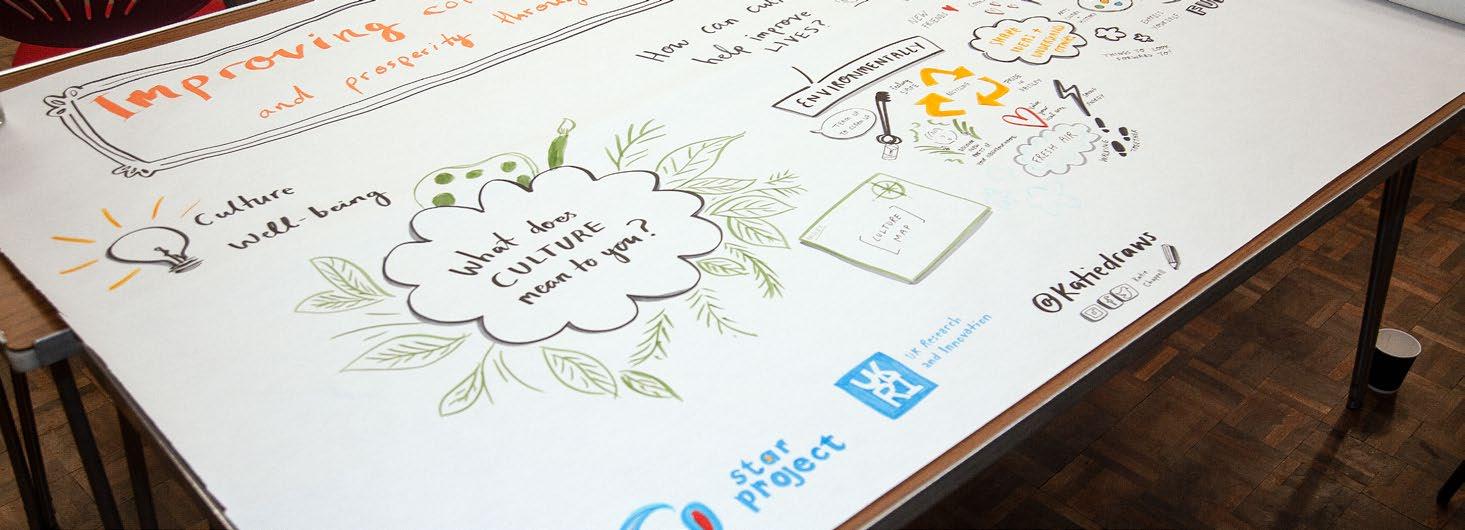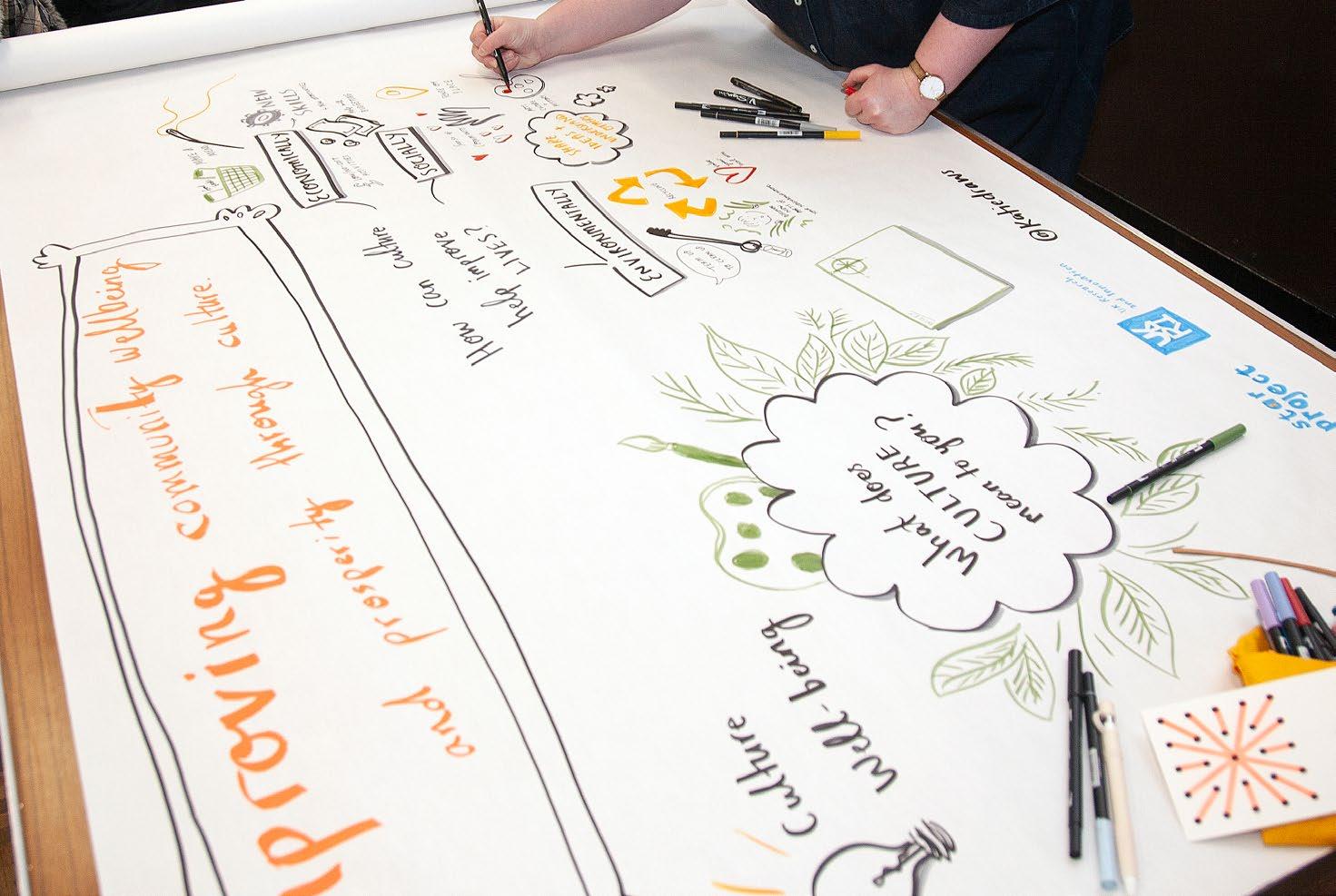
6 minute read
5.0 Social Prescribing
from The Role of Arts & Culture in Lifting Communities Out of Poverty, A Review of Evidence
by ccse_uws
Matarasso (2017) advocates for co-creation as a mode of production (c.f. participation), noting that ‘an artist intending to co-create […] has to find ways to disperse the power associated with their skill, knowledge, experience and position.’ A transition from hierarchy to network based working denotes a democratisation of production is the crucial step to realising the potential of culture in this space (coproduction) (Matarasso, 2017). UK based examples of projects and interventions which seek to address elements of material poverty and local community agency include Home Baked17 in Liverpool and Slung Low18 located in Leeds. The Welsh government’s Fusion Programme comprises a foremost example of a formal, executive-led intervention prioritising a recognition of material poverty in the manner we have described. Homebaked is ‘a community land trust and co-operative bakery situated on the boundary between the neighbourhoods of Everton and Anfield, just opposite the Liverpool Football Club’ that began life as 2up2down; was part of Liverpool Biennial. The undertaking employed an artist to facilitate local community reflection on what people wanted to do for themselves in the wake of a failed housing market regeneration initiative and, longer term, to take some decisions with regard to creating economic opportunity. As a business co-owned and staffed/run by locally resident community members, the bakery has hard economic outputs which benefit the local community in addition to the civic and social value it brings to the community. Homebaked pays the living wage, reinvesting profits into local economy. There work is, they say, ‘based on the simple belief that we all deserve to live well. For us, that means good jobs, secure homes, great food and welcoming spaces to meet, share stories, learn and celebrate’. Slung Low has been operating since 2000, it is ‘an award-winning theatre company specialising in making epic productions in non-theatre spaces, often with large community performance companies at their heart’. Slung Low run a working men’s club, a college and a woodland. They have been closely involved in supporting vulnerable community members during the COVID19 lockdown. Paying hourly work at the living wage, much of their work is shown on a ‘pay what you decide’ basis; their space and equipment can also be hired thus. The Slung Low approach foregrounds a very specific and committed set of values with regard to income inequality and a specific set of mechanisms through which this might be addressed. Economic transparency and equality is central to Slung Low’s ethos (they operate a horizontal wage structure). Their work seeks to address issues of access for the economically excluded along with activity aimed at the amelioration of urgent problems arising directly from material poverty (i.e. lack of food).
Building on the recommendation of Baroness Andrews’ 2014 report – Culture & Poverty, Response by the Welsh Government: harnessing the power of the arts culture and heritage to promote social justice in Wales – Fusion is a M(useums), A(rchives) and L(ibraries) D(ivision) led initiative to ‘provide cultural activity that can help tackle poverty’ (Welsh Government, 2019:4). Within the framework of a national programme, Fusion prioritises partnerships at the local level as the most efficacious way to delivery ‘genuine collaboration and better outcomes’ (Welsh Government, 2019:4). In the period 2015-17, over 5,000 people participated in Fusion’s activities alongside 150 partner organisations comprising local authorities, theatres, heritage organisations, schools, museums, libraries and archives. Over 100 people were assisted in gaining qualifications (i.e. through the Cultural Ambition programme 19), 300 volunteering opportunities were created and 1,500 school aged children were supported to achieve better educational outcomes (Welsh Government, 2019:4).
Advertisement
Data gathered from across the Fusion projects clearly evidences outcomes that positively affect participants’ employment prospects as well as those that speak to a wellbeing agenda:
Table of Fusion Indicators (Welsh Government, 2019:5)
Fusion Indicator
F1 Supporting early years & family learning F2 gaining a qualification F3 Regular volunteering as a route to work F4 Completing a work experience placement F5 Improved digital skills F6 Improved attitude to formal learning F7 Better able to manage mental wellbeing and physical health
17-18
4979 423 332 110 50 2689 2941
18-19
13087 720 761 160 997 3046 5400
17 http://homebaked.org.uk/ 18 https://www.slunglow.org/ 19 This programme supported 33 young people to achieve NVQ level 2 Cultural Heritage qualification having previously been not in education, employment or training (Welsh Government, 2019:6).
There are many areas of intersection with the themes and approaches that have been outlined above in the growing literature on social prescribing.20 Here the outcomes for patients are described in terms framed by wellbeing agendas (i.e. Bungay & Clift, 2010:281). It is notable too that the recently published Culture Strategy for Scotland utilises articulations of poverty reduction that are positioned within the wellbeing agenda (Scottish Government, 2019). For local authorities and health services, return on investment is identified in economic cost saving resulting from fewer medical appointments and referrals. Researchers and practitioners have identified the areas of overlap between individuals’ medical and social lives. Polley et al note that approximately 20 per cent of patients attend their ‘GP for what is primarily a social problem’ (Polley et al, 2017; also see South, 2008:214; Adbowale et al, 2014:14; Cawston, 2011; 350; Foley et al, 2007:17). Thus, while community health initiatives may endeavour to involve socially excluded communities in their work ‘general practice remains a key point of access, including for those presenting with social needs’ (South et al 2008: 310). Taking heed of patients’ day-to-day lives and concerns is a vital for the delivery of good quality medical care (Cawston, 2011:350; also Bungay & Clift, 2010:280).21
Among the challenges faced by patients, those of ‘low pay, alienating work conditions, low expectations, poor educational achievement, ready access to drugs and addiction including alcohol and tobacco, worklessness, poor nutrition and poor physical and mental health’ are among the most pressing (Cawston, 2011:350). The intersection between these challenges, material poverty - and its recognised effects - is clear. While the connections between community and voluntary sectors and the primary health care services in the UK are rarely well developed, social prescribing provides a platform for the utilisation of the voluntary sector within primary healthcare (South et al, 2008:310. Also see: Chatterjee et al, 2017:58; Thomson et al, 2015).
Novel opportunities for innovations crosscutting these areas, further developing established programmes of arts on prescription – where practitioners refer service users to an arts activity or service as a source of support – have arisen on the basis of the Health & Social Care Act (Daykin et al, 2017:124). Though Bickerdike et al point out that there is still scope for improving the robustness of social prescribing evaluations (Bickerdike at al, 2017; also Rempel et al, 2017; Husk et al, 2020),22 Bashir and Dayson (2014:45) provide an overview of the characteristics of models of social prescription.23 These authors (2014:21) provide a list of wellbeing outcomes that emerged from the research they conducted in parallel with a 24-month social prescribing pilot undertaken in Rotherham between April 2012 and March 2014 (also see Thomson et al, 2015:22). The outcomes inventory was developed as part of an evaluation framework to provide baseline and follow up data with focus on gauging changes in wellbeing measures: Feeling positive: hope, learning to cope and feeling calm Lifestyle: sleeping habits, smoking, diet and exercise Looking after yourself: shopping, going out, transport and personal care Managing symptoms: energy levels, pain, information and medication Work, volunteering and other activities: new roles, volunteering and social groups Money: debt advice, benefits and managing money Where you live: heating, local facilities, stairs and fire safety Family and friends: isolation, carer support
20 Also known as ‘social referral’ or ‘community referral,’ see Rempel et al, (2017). 21 Also, Mossabir et al (2015:402) note that ‘in almost all the papers [included in the review] it was found that health professionals played an important role in referring patients to the interventions and in introducing the notion of utilising community groups with aspects of health management.’ 22 Husk et al (2020) identify enrolment, engagement and adherence as key loci for evaluation. They also argue that link workers are vital for assisting successful navigation of the social prescribing ‘pathway’. Also see Thomson et al, (2015:5). 23 Cawston (2011:350) also lists the types of activities from which interventions might be comprised. Also see Chaterjee et al (2017:98-100) and Thomson et al, (2015:1021).








